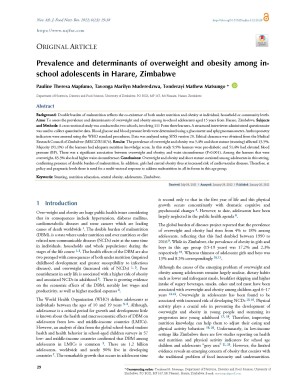Prevalence and determinants of overweight and obesity among in-school adolescents in Harare, Zimbabwe
Abstract
Background: Double burden of malnutrition reflects the co-existence of both under nutrition and obesity at individual, household or community levels. Aims: To assess the prevalence and determinants of overweight and obesity among in-school adolescents aged 15 years from Harare, Zimbabwe. Subjects and Methods: A cross-sectional study was conducted in two schools, involving 111 Form three learners. A structured interviewer administered questionnaire was used to collect quantitative data. Blood glucose and blood pressure levels were determined using a glucometer and sphygmomanometer. Anthropometry indicators were assessed using the WHO standard procedures. Data was analyzed using SPSS version 20. Ethical clearance was obtained from the Medical Research Council of Zimbabwe (MRCZ/B/1876). Results: The prevalence of overweight and obesity was 5.4% and short stature (stunting) affected 13.5%. Majority (91.1%) of the learners had adequate nutrition knowledge score. In this study 9.9% learners were pre-diabetic and 51.4% had elevated blood pressure (BP). There was a significant association between overweight and obesity; and waist circumference (P<0.001). Among the learners that were overweight, 83.3% also had higher waist circumference. Conclusions: Overweight and obesity and short stature coexisted among adolescents in this setting, confirming presence of double burden of malnutrition. In addition, girls had central obesity thus at increased risk of cardiovascular diseases. Therefore, at policy and pragmatic levels there is need for a multi-sectoral response to address malnutrition in all its forms in this age group.
Full text article
Authors
Copyright (c) 2022 Pauline Theresa Mapfumo, Tavonga Marilyn Muderedzwa, Tonderayi Mathew Matsungo

This work is licensed under a Creative Commons Attribution 4.0 International License.
-
Attribution — You must give appropriate credit, provide a link to the license, and indicate if changes were made. You may do so in any reasonable manner, but not in any way that suggests the licensor endorses you or your use.
-
No additional restrictions — You may not apply legal terms or technological measures that legally restrict others from doing anything the license permits.





